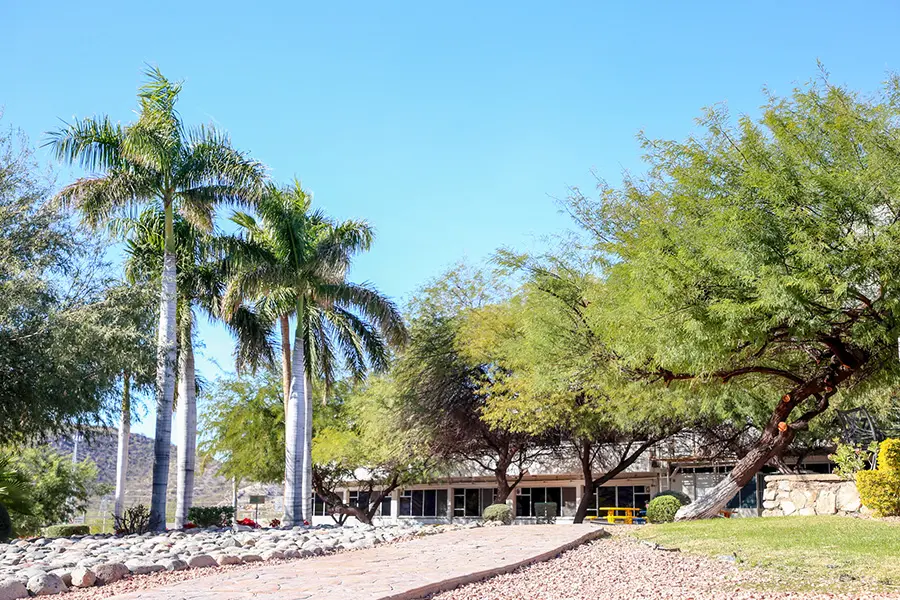Did you know that Tec de Monterrey has over 70,000 trees across its 22 campuses, which is the equivalent of one tree to every 1.4 students?
However, besides being a decorative part of the landscape, trees represent an environmental commitment, an opportunity to generate an ecosystem that benefits the community, according to Martín Salgado, the Tec’s Strategic Leader of Water and Environment.
To mark Arbor Day in Mexico, which is celebrated on the second Thursday of July, Salgado spoke about the importance of maintaining green spaces at the educational institution.
“It’s not only about trying to beautify our surroundings but also about generating microclimates that benefit the community. There are many benefits besides the ecosystemic one. For example, they’re home to thousands of species and reduce stress,” he said.

He also said that they bring fundamental benefits to combat climate change as they are essential for sequestering carbon dioxide.
“They also serve to regulate temperature, making our cities cooler.
“In terms of their biological process, they help us by absorbing CO2 to turn it into oxygen, which helps us a great deal, above all in such polluted cities,” he added.
“It’s not only about trying to beautify our surroundings but also about generating microclimates that benefit the community".
Species according to the region and needs of the ecosystem
According to the most recent report from the Tec’s Ruta Azul sustainability plan, the most common tree species are tropical ash, eucalyptus, pine, river tamarind, and southern live oak.
“We don’t plant for the sake of planting. Every species has a purpose, from their adaptation to the soil and climate to their ecosystemic role.
“The most representative trees are the Montezuma cypress, tropical ash, oak, jacaranda, and buddleia,” he said.
He mentioned that some of the trees on campuses are over thirty years old, whereas others have been gradually incorporated as part of ecological restoration efforts.

The data presented by Ruta Azul highlight that 58% of species are of regional or native origin, while 42% of trees are exotic species.
What’s more, each campus is establishing a plant palette to choose the correct trees in accordance with its needs and characteristics.
“It’s a list, so to speak, of species from the region, which is held by the campus’s operations department. This means that if we want to reforest or set up a new project, these campuses will already have the criteria from which to select the ideal species.
“We use slightly stricter criteria: not only do we prioritize esthetics, but we also look for native trees or trees from the region that can adapt easily to the climate or that are low maintenance,” said Martín.
It is important to point out that each campus has its process for maintenance operations and guidelines for the care of green areas.

Green areas: Benefits for all
Salgado says that we should maintain green areas and avoid cutting down trees so as not to alter the ecosystem of thousands of species, which also bring physical benefits for humanity.
“Although we might not see it with the naked eye, they maintain relative stability in the world. We urge you to care for our natural spaces and areas because these bring not only physical benefits but mental ones too.
“Trees help us to reduce stress and increase dopamine. There are many benefits, so we all end up winning,” he concluded.
If you’d like to learn more about this subject, check out the adaptation section of Ruta Azul’s 2025 Sustainability and Climate Change Plan.
Tiny Forest: The Tec project that uses the Miyawaki Method
At Tec de Monterrey, a group of research professors was inspired by the Miyawaki Method to carry out a project called Tiny Forest, which aims to make hundreds of trees, shrubs, and grasses grow quickly.
It will also have sensors to measure moisture and plant growth.
This space lies on Monterrey campus, in a 10-square-meter patch of land facing two avenues.
Rob Roggema, a distinguished professor at the School of Architecture, Art, and Design (EAAD), member of the Tec’s Faculty of Excellence initiative, and expert on regenerative design, says that around 350 trees and plantswere planted there.
The Miyawaki Method has been proven to make forests grow up to ten times faster with thirty times the density of traditional ones.
This concept was developed by Japanese botanist Akira Miyawaki, who aimed to encourage the growth of trees and plants, save water, and improve soil quality.
The technique consists of planting over 100 different species that are native to the region in the same area to promote competition for space.

Other efforts on Monterrey campus
distritotec has also worked with neighbors and municipal authorities to carry out tree-planting projects that improve the appearance of public common spaces in the neighborhoods adjoining Monterrey campus.
With information from Ricardo Treviño / TecScience
ALSO READ:





